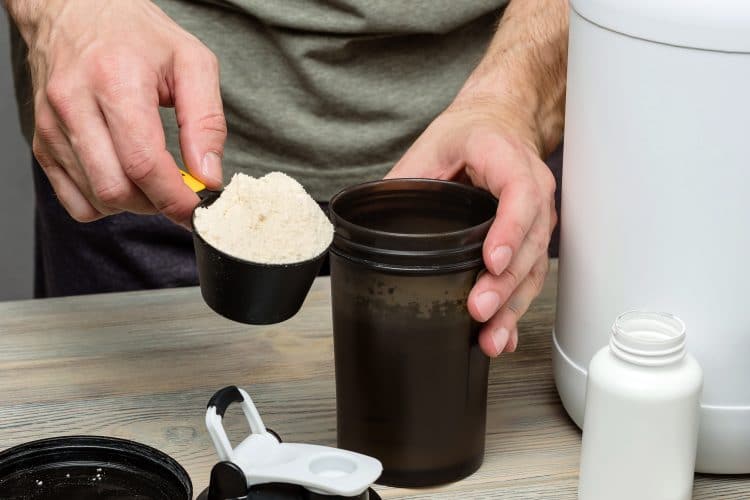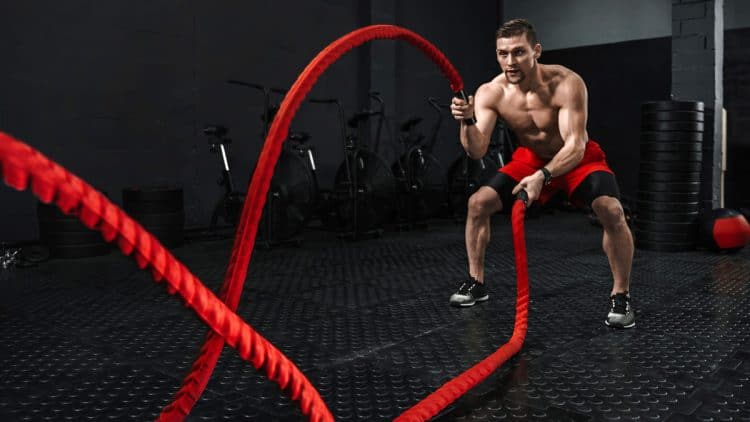Bodybuilders have used the bulking and cutting protocol for decades to build their physiques. The process is simple: bulk up to add muscle mass, cut down to strip off fat, rinse and repeat.
This method has a few problems, including the possible loss of hard-earned muscle during the cutting phase and the need to overeat during the bulking phase. So, is there a better way?
Maybe.
Body recomposition is a concept that has gained popularity in bodybuilding circles. It’s a method that allows you to gain muscle and lose fat simultaneously.
So, is it better than bulking and cutting?
To find out, I decided to test the theory of body recomposition for 90 days. The results? Absolutely astounding. Read on to find out what happened and why.
Level Up Your Fitness: Join our 💪 strong community in Fitness Volt Newsletter. Get daily inspiration, expert-backed workouts, nutrition tips, the latest in strength sports, and the support you need to reach your goals. Subscribe for free!
My Recomp Experience
Going into my three-month recomposition, I was in what you could call a de-trained state. I had been working out with weights for many years but had gotten out of my routine. For the past six months, my workouts had been haphazard at best. As a result, I’d gained about seven pounds of fat and lost several pounds of muscle mass.
Nutrition Preparation
The first step was to work out my caloric intake. I needed to hit that sweet spot between being low enough to stimulate fat loss and not too low that it prevents muscle gain.
A 2011 study showed that elite athletes could add muscle mass and lose fat simultaneously by achieving a goal of losing 0.7% of bodyweight per week [1]. I used these findings to guide my caloric intake.
My starting body weight was 215.6 pounds (98 kilograms). A loss of 0.7% equates to 1.5 pounds. Using the Fitness Volt calorie calculator, I calculated my caloric maintenance level to be 3,296 calories.
One pound of fat contains around 3,500 calories. So, to lose 1.5 pounds per week, I would have to create a weekly deficit of 5,250 calories — that’s 750 calories per day. I decided that 500 calories would be lost through reduced caloric intake and 250 through cardio to burn calories.
I could now work out my daily calorie goal:
3,296 – 750 = 2,546 calories.
My next step was to work out my daily protein intake. A 2016 study showed that a higher protein intake than the generally recommended 0.8 grams per pound of body weight is needed to build muscle when you’re on a calorie deficit. The study’s authors recommended a daily intake of 1.0-1.6 grams per pound of body weight when you’re on a caloric deficit. [2]

I decided to go with 1.5 grams per pound of body weight. That worked out to 323 grams of protein per day.
The final step was to plan out my nutrient timing. Having experienced intermittent fasting, I decided that the easiest way for me to reduce my calories by 500 was to drop breakfast. My typical breakfast consists of oatmeal with berries and walnuts sprinkled with whey protein powder. The calorie content of that meal is very close to 500.
To provide the needed energy for my workouts, I planned to have a meal of two slices of toast topped with mashed banana 30 minutes before my training session. Within 30 minutes of the workout, I would have a 50/50 blend of whey protein and complex carbs to promote muscle protein synthesis and replace muscle glycogen levels.
The rest of my meals would be spaced three hours apart.
Try also Body Recomposition Calculator!
The Workouts
I followed a push/pull/legs training program, training each body part twice weekly. My cardio consisted of four 30-minute steady state (SS) sessions on a treadmill at a 12-degree incline at 3 miles per hour and three high-intensity interval workouts on the treadmill. These consisted of a 2-minute warm-up followed by eight 20-second sprints, with ten-second rest intervals.
The cardio would be done on an empty stomach first thing in the morning.
Here’s what my weekly workout schedule looked like:
Level Up Your Fitness: Join our 💪 strong community in Fitness Volt Newsletter. Get daily inspiration, expert-backed workouts, nutrition tips, the latest in strength sports, and the support you need to reach your goals. Subscribe for free!
| Monday | Tuesday | Wednesday | Thursday | Friday | Saturday | Sunday |
| Push | Pull | Legs | Push | Pull | Legs | – |
| SS Cardio | HIIT | SS Cardio | HIIT | SS Cardio | HIIT | SS Cardio |
How It Went

The first few days of this program were challenging. I had to get my mind and body programmed to not eat early in the morning and do cardio on an empty stomach. By Thursday of Week One, though, I was into the rhythm of this eating and training protocol.
The eating plan’s simplicity made it easy to implement. There was no calorie counting or having to second-guess what I was putting in my mouth. I guess I was lucky because I already had relatively clean eating habits. So, all I had to do was cut out breakfast, get a bit stricter on the weekends, and eat as usual.
When it came to my strength training workouts, I used a wide rep range to hit every muscle fiber. My first set on my big lifts was 30 reps. Then I’d add weight for 20 reps on set two. Over five sets, I’d work down to six reps on my final set.
My goal was to either add weight or pump out an extra rep on the last set of every exercise every week. I didn’t manage this perfectly, but I came pretty close. For example, my dumbbell bench press went from 65 pounds for six reps in Week One to 90 pounds for five reps in week 12.
Understanding Body Recomposition
Body recomposition is when you lose weight and gain muscle simultaneously. It contrasts with the more traditional bodybuilding method of bulking and cutting. The recomp method avoids the need to consume huge amounts of food when bulking and cutting way back during the shredding phase.
Another protocol is lean gains, which aims to add fat-free muscle mass.
Recomposition Benefits
- Steady Muscle Gain and Fat Loss: The recomp method promotes slow, gradual muscle gain while losing body fat. It avoids the sudden weight changes that come with a bulk and cut protocol. Many people consider this to be a safer method of improving body composition.
- Improved Metabolic Health: Recomposition may be better for your metabolic health than the bulking and cutting method. When you eat a lot of simple carbohydrates and unhealthy fats while bulking, you are at risk of insulin resistance and metabolic syndrome.
- Sustainable Lifestyle: Recomping does not involve drastic extremes in eating, and so is thought by many to be more sustainable over the long term than bulking and cutting.
The Science Behind Recomposition
The idea that you can build muscle and lose fat simultaneously was long viewed as unrealistic in bodybuilding circles. Yet, recent scientific evidence suggests otherwise.
A 2013 study compared two groups of weight trainers over 12 weeks. The first group followed a maintenance diet, while the second consumed 600 calories per day above their maintenance level. At the end of the trial, both groups had gained a similar amount of muscle mass. However, the extra-calorie group had gained three times as much fat as the maintenance group. [3]
This study suggests that bulking runs the risk of excess fat gain without the reward of gaining more muscle than if you followed a maintenance diet.
A 2020 meta-analysis collated the existing research on body recomposition. It found that body recomposition, defined as simultaneous fat loss and muscle gain, is achievable with a combination of the following:
- A progressive resistance training program that is done at least three times weekly.
- Consuming calories at the rate of 2.6-3.5 grams per kilogram of fat-free mass.
- Supplementing with whey and casein protein to maximize protein synthesis.
- Prioritizing sleep quality and quantity. [4]
Recomposition relies on three foundational concepts:
1. Metabolism and Muscle Growth
Recomposition involves the dual processes of muscle growth and metabolism. Muscle growth happens when muscle fibers stressed through resistance training are repaired and built back slightly bigger. This process relies on protein, anabolic hormones like insulin and testosterone, and rest. [5]
Fat loss requires a caloric deficit, so the body burns more calories than it takes in, creating a negative energy balance. The body uses stored body fat to get the energy needed to function.
These two processes need to occur simultaneously. For that to happen, you must pay careful attention to your nutrition, exercise, and recovery.
2. Nutrition
Macronutrient balance is essential for body recomposition. High-quality protein is needed for muscle repair and growth. It provides the building material to rebuild muscle tissue post-workout.
Carbohydrates are the body’s primary source of energy for workouts in the form of glycogen. After the workout, your muscles are depleted of glycogen. Carbs are needed to restore those levels and promote workout recovery.
Healthy fats are needed to support the production of muscle-promoting hormones like testosterone and growth hormone. At nine calories per gram, they also provide a concentrated form of energy.
Finding the ideal caloric intake to support muscle growth and fat loss is key to successful recomposition. A slight caloric deficit, high protein intake, and strategic nutrient timing are recommended.
3. Training
Recomposition training combines resistance workouts to stimulate muscle growth with cardio to burn calories. Cardio workouts may involve high-intensity interval training (HIIT), steady state, or a combination of the two.
Conclusion
Going into my 90-day recomposition program, I was skeptical. I’d bought into the general belief that fat loss and muscle gain were competing goals that don’t work together.
But seeing is believing.
The results I achieved were nothing short of amazing. And I achieved those results without uncomfortable overeating or restrictive dieting. This experience has completely changed my approach, proving that with the right strategy, you can indeed build muscle and lose fat simultaneously.
References
- Garthe I, Raastad T, Refsnes PE, Koivisto A, Sundgot-Borgen J. Effect of two different weight-loss rates on body composition and strength and power-related performance in elite athletes. Int J Sport Nutr Exerc Metab. 2011 Apr;21(2):97-104. doi: 10.1123/ijsnem.21.2.97. PMID: 21558571.
- Longland TM, Oikawa SY, Mitchell CJ, Devries MC, Phillips SM. Higher compared with lower dietary protein during an energy deficit combined with intense exercise promotes greater lean mass gain and fat mass loss: a randomized trial. Am J Clin Nutr. 2016 Mar;103(3):738-46. doi: 10.3945/ajcn.115.119339. Epub 2016 Jan 27. PMID: 26817506.
- Garthe I, Raastad T, Refsnes PE, Sundgot-Borgen J. Effect of nutritional intervention on body composition and performance in elite athletes. Eur J Sport Sci. 2013;13(3):295-303. doi: 10.1080/17461391.2011.643923. Epub 2012 Mar 1. PMID: 23679146.
- Baraket C, Pearson J. (2020). Body recomposition: Can trained individuals build muscle and lose fat at the same time? Strength & Conditioning Journal, Publish Ahead of Print(5). https://doi.org/10.1519/SSC.0000000000000584
- Garthe I, Raastad T, Refsnes PE, Sundgot-Borgen J. Effect of nutritional intervention on body composition and performance in elite athletes. Eur J Sport Sci. 2013;13(3):295-303. doi: 10.1080/17461391.2011.643923. Epub 2012 Mar 1. PMID: 23679146.










